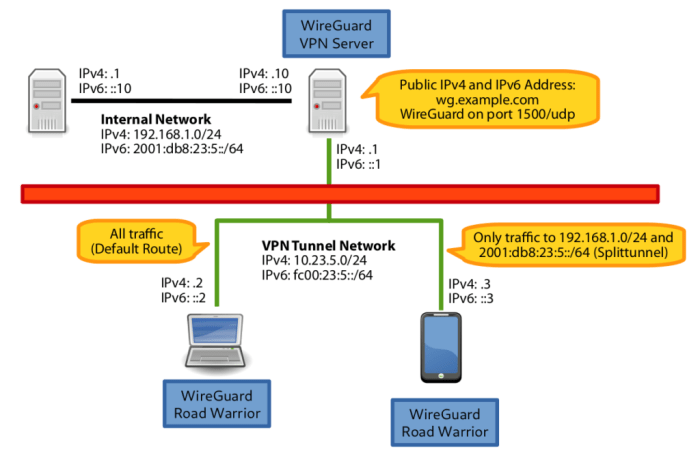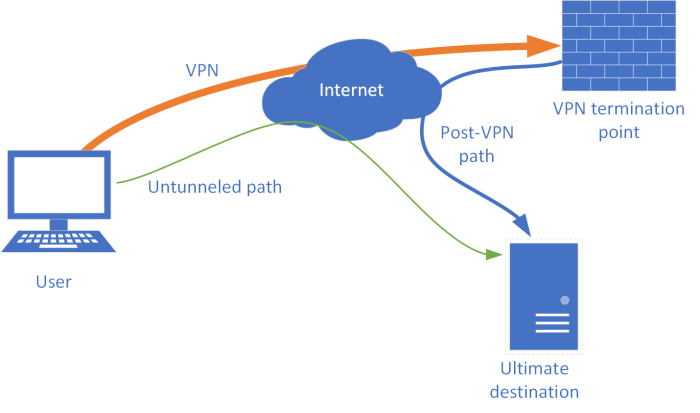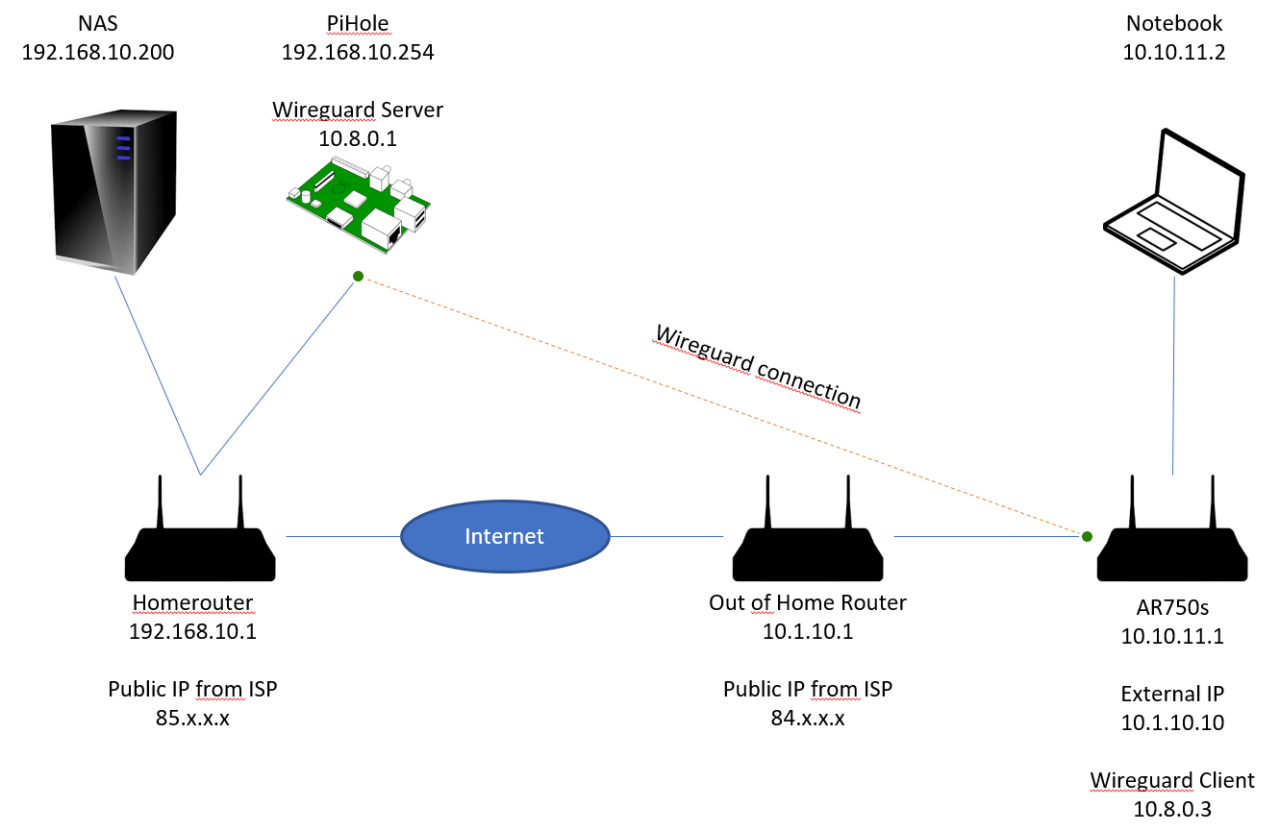ssh.sshslowdns.com – In the realm of virtual private networks (VPNs), WireGuard has emerged as a game-changer, offering unparalleled speed, security, and versatility. Among its many features, WireGuard’s split tunneling capability stands out as a groundbreaking innovation that empowers users with granular control over their network traffic.
Split tunneling allows you to selectively route specific traffic through the VPN tunnel while maintaining direct access to your local network for other applications. This hybrid approach offers a unique blend of enhanced security for sensitive data and improved performance for local network access.
Overview of WireGuard VPN Split Tunneling
Split tunneling is a feature in virtual private networks (VPNs) that allows users to route specific traffic through the VPN while other traffic is sent over the regular internet connection. This can be useful for tasks that require a high-speed connection, such as streaming video or gaming, while still protecting sensitive data on the VPN.
WireGuard is a modern VPN protocol that supports split tunneling. WireGuard’s split tunneling implementation is based on the use of routing tables. When a WireGuard VPN is active, it creates a new routing table that is used to route traffic through the VPN.
Traffic that is not destined for the VPN is routed over the regular internet connection.
WireGuard’s split tunneling feature is easy to configure. Users can simply add a rule to their WireGuard configuration file that specifies which traffic should be routed through the VPN. For example, the following rule would route all traffic destined for the 192.168.1.0/24 subnet through the VPN:
[Interface]Address = 10.0.0.1/24ListenPort = 51820PrivateKey = [Peer] PublicKey = AllowedIPs = 192.168.1.0/24
Benefits of Using WireGuard VPN Split Tunneling
WireGuard VPN split tunneling offers several key benefits for users seeking to balance security and performance.
Improved Performance for Local Network Access
Split tunneling allows certain traffic to bypass the VPN tunnel, resulting in improved performance for local network access. This is particularly beneficial for tasks that require high bandwidth, such as streaming media or gaming, as it reduces latency and improves overall responsiveness.
Enhanced Security for Sensitive Data
By selectively routing traffic through the VPN tunnel, split tunneling enhances security for sensitive data. This is because only the traffic that requires encryption is routed through the VPN, while other traffic remains on the local network. This reduces the risk of data breaches or unauthorized access to sensitive information.
Flexibility in Routing Traffic
Split tunneling provides flexibility in routing traffic based on specific criteria, such as IP address, port number, or application. This allows users to tailor their VPN configuration to meet their specific needs. For example, users can route only work-related traffic through the VPN while keeping personal traffic on the local network.
Configuring WireGuard VPN Split Tunneling

Setting up split tunneling in WireGuard involves configuring the VPN interface and the firewall rules to route specific traffic through the tunnel while allowing other traffic to bypass it.
Here are the general steps to configure WireGuard split tunneling:
- Create a WireGuard interface and configure the VPN settings.
- Configure the firewall rules to redirect traffic through the WireGuard interface.
- Enable IP forwarding on the server to allow traffic to be routed through the VPN interface.
- Configure the firewall rules on the client to allow traffic to bypass the VPN interface for specific destinations.
Creating the WireGuard Interface
To create a WireGuard interface, use the following command:
wg-quick up
Replace with the name of the interface you want to create, such as wg0 .
Configuring Firewall Rules
Once the WireGuard interface is created, you need to configure the firewall rules to redirect traffic through the VPN interface. On Linux, you can use the following commands:
iptables
- t nat
- A POSTROUTING
- o
- j MASQUERADE
iptables
- A FORWARD
- i
- o
- j ACCEPT
iptables
- A FORWARD
- i
- o
- j ACCEPT
Replace with the name of the WireGuard interface and with the name of the LAN interface.
Enabling IP Forwarding
To enable IP forwarding on the server, edit the /etc/sysctl.conf file and add the following line:
net.ipv4.ip_forward=1
Then, apply the changes with the following command:
sysctl
p
Configuring Firewall Rules on the Client
On the client, you need to configure the firewall rules to allow traffic to bypass the VPN interface for specific destinations. For example, to allow traffic to your local network to bypass the VPN, you can use the following command:
iptables
- t nat
- A OUTPUT
- d
- j RETURN
Replace with the IP range of your local network.
Troubleshooting WireGuard VPN Split Tunneling

Resolving issues with WireGuard VPN split tunneling involves identifying common problems and applying effective solutions. Additionally, advanced troubleshooting techniques can assist in diagnosing and addressing more complex challenges.
Common Issues and Solutions
- No Internet access on local network: Ensure the VPN interface is excluded from the split tunnel configuration and that the default gateway is set correctly.
- DNS leaks: Verify that the DNS server settings are properly configured on the client device and that the VPN server is using a private DNS server.
- Slow performance: Check the network connection speed and optimize the VPN server settings, such as MTU size and encryption algorithms.
Advanced Troubleshooting Techniques
Advanced troubleshooting techniques include:
- Packet sniffing: Capture and analyze network traffic to identify any anomalies or packet drops.
- Log analysis: Examine the VPN server and client logs for error messages or unusual activity.
- Kernel debugging: Enable kernel debugging on the VPN server and client to gather detailed information about the VPN process.
Comparison with Other VPN Protocols
WireGuard stands out in the VPN landscape due to its innovative approach to split tunneling. Here’s how it compares to other popular VPN protocols:
OpenVPN
- Advantages: Mature and widely used, OpenVPN offers robust encryption and a comprehensive feature set, including split tunneling.
- Disadvantages: Slower performance compared to WireGuard, especially on resource-constrained devices.
IPsec
- Advantages: Widely deployed in corporate networks, IPsec provides strong security and interoperability with legacy devices.
- Disadvantages: Complex to configure and manage, with limited support for split tunneling.
PPTP
- Advantages: Simple to set up and compatible with a wide range of devices, making it a popular choice for home users.
- Disadvantages: Insecure by modern standards, with known vulnerabilities that compromise user privacy and security.
L2TP/IPsec
- Advantages: Offers a balance between security and performance, supporting split tunneling and working well with older devices.
- Disadvantages: Can be more complex to configure than WireGuard and may suffer from performance issues on resource-constrained devices.
IKEv2
- Advantages: Fast and reliable, IKEv2 supports split tunneling and is commonly used on mobile devices.
- Disadvantages: Not as widely deployed as other protocols, and may require specific hardware or software support.
Use Cases for WireGuard VPN Split Tunneling

WireGuard VPN split tunneling offers various benefits and use cases, making it a valuable tool for organizations and individuals. Here are some real-world examples:
Accessing Local Resources
Split tunneling allows users to access local resources while connected to a VPN, ensuring seamless connectivity. For instance, an employee working from home can access company intranet resources while still having access to local devices like printers and scanners.
Optimizing Performance
Split tunneling improves performance by directing only essential traffic through the VPN. For example, a user downloading large files can route the traffic through their local internet connection, bypassing the VPN and avoiding potential slowdowns.
Security and Compliance
Split tunneling enhances security by protecting sensitive data while allowing access to non-critical resources. In healthcare, medical records can be kept secure on the VPN while allowing access to general websites.
Remote Work and Collaboration
Split tunneling enables secure and efficient remote work. Team members can access company resources securely while still having access to local resources like file servers and shared drives.
Streaming and Gaming
Split tunneling allows users to enjoy streaming and gaming without compromising latency or bandwidth. By routing non-VPN traffic through the local connection, users can minimize lag and buffering issues.
Best Practices for Using WireGuard VPN Split Tunneling
Optimizing split tunneling performance and maintaining security require adherence to best practices. This section provides guidance on maximizing efficiency and safeguarding data.
Security Considerations:
- Limit Access to Sensitive Data: Configure split tunneling rules to prevent sensitive data from traversing the public network.
- Use Strong Encryption: Ensure WireGuard is configured with robust encryption algorithms, such as ChaCha20 or AES-256, to protect data in transit.
- Monitor VPN Connections: Regularly monitor VPN connections to detect and respond to any suspicious activity.
Performance Optimization:
- Identify Critical Traffic: Determine which applications and services require VPN protection and route them through the VPN tunnel.
- Exclude Non-Essential Traffic: Exclude non-critical traffic from the VPN tunnel to improve performance and reduce bandwidth consumption.
- Use a High-Speed VPN Server: Select a VPN server with high bandwidth and low latency to ensure optimal performance.
- Consider Load Balancing: Implement load balancing techniques to distribute traffic across multiple VPN servers, improving reliability and performance.
Advanced Topics in WireGuard VPN Split Tunneling
WireGuard VPN split tunneling offers advanced configuration options to cater to specific networking requirements. These options include:
- Custom rules: Define granular rules to specify which traffic should be routed through the VPN tunnel and which should bypass it.
- Routing tables: Create and manage custom routing tables to control the flow of traffic based on specific criteria.
Custom Rules
Custom rules allow you to specify detailed conditions for traffic routing. For example, you can configure rules to:
- Route traffic from a specific application or port through the VPN tunnel.
- Exclude certain IP addresses or subnets from the VPN tunnel.
- Set priorities for different traffic types, ensuring critical traffic always takes precedence.
Routing Tables
Routing tables provide a more comprehensive way to control traffic flow. You can create multiple routing tables and assign them to different interfaces or VPN connections. This allows you to segregate traffic and optimize network performance.By leveraging these advanced options, you can fine-tune your WireGuard VPN split tunneling configuration to meet your specific needs, such as:
- Improving security by routing sensitive traffic through the VPN tunnel while allowing general browsing to bypass it.
- Optimizing performance by excluding bandwidth-intensive applications from the VPN tunnel.
- Providing granular control over network access for different users or devices.
Limitations of WireGuard VPN Split Tunneling
WireGuard VPN split tunneling, while offering advantages, also has some limitations to consider.
One potential limitation is the increased complexity in managing network configurations. Split tunneling requires careful configuration to ensure that only specific traffic is routed through the VPN tunnel, while other traffic bypasses it. This can be challenging to implement and maintain, especially in complex network environments.
Security Considerations
Split tunneling also introduces potential security risks. By allowing some traffic to bypass the VPN tunnel, it creates a potential entry point for attackers to access the internal network. To mitigate this risk, it is essential to implement strong security measures, such as firewalls and intrusion detection systems, to monitor and protect the network.
Future of WireGuard VPN Split Tunneling
WireGuard VPN split tunneling is a rapidly evolving technology with a promising future. Recent advancements and ongoing developments indicate that split tunneling will become increasingly sophisticated and user-friendly.
Future enhancements are likely to focus on improving performance, enhancing security, and simplifying configuration. As the technology matures, we can expect to see broader adoption across various industries and applications.
Innovations in Performance Optimization
Developers are actively working on optimizing WireGuard VPN split tunneling performance. Innovations in encryption algorithms and protocol enhancements will enable faster and more efficient data transfer. This will significantly improve the user experience, especially for bandwidth-intensive applications like video conferencing and file sharing.
Enhanced Security Measures
Security is paramount in VPN technologies. Future developments in WireGuard VPN split tunneling will prioritize strengthening security measures. Advanced encryption techniques, such as post-quantum cryptography, will be integrated to protect against emerging threats. Additionally, improved key management and authentication protocols will enhance overall security.
Simplified Configuration and Management
Simplifying configuration and management is crucial for wider adoption. Future efforts will focus on developing user-friendly interfaces and automating complex tasks. This will make it easier for users to set up and manage split tunneling, reducing the need for technical expertise.
Emerging Applications and Use Cases
As WireGuard VPN split tunneling technology advances, it will find applications in various emerging areas. For instance, it can be used to secure IoT devices, enhance cloud computing security, and support remote work and distributed teams more effectively.